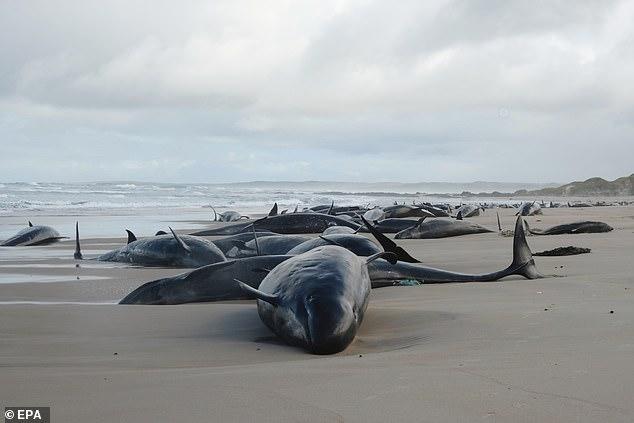In the haunting stillness of a remote Tasmanian shoreline, nature’s tragic narrative unfolded as dozens of sleek, dark-bodied false killer whales lay silent against the weathered sands. This unexpected mass stranding—a somber tableau of marine vulnerability—serves as a stark reminder of the delicate ecological balance that sustains life beneath the waves. As scientists and conservationists rushed to understand the circumstances behind this devastating event, the beach became a poignant canvas illustrating the ongoing challenges faced by marine species in an increasingly complex and unpredictable world. In a haunting maritime tragedy, the rugged shores of Tasmania became an unexpected graveyard for a significant number of marine mammals, highlighting the fragile ecosystem of the Southern Ocean. The critically endangered false killer whales, despite their misleading name, are not actually whales but large members of the dolphin family, met a devastating fate on the isolated coastline.
Local wildlife conservation teams were alerted by concerned beachgoers who first discovered the massive marine mammals stranded along the remote beach. Initial assessments revealed approximately 40-50 individuals of this rare species had perished, creating a somber scene of ecological distress.
Marine biologists immediately launched a comprehensive investigation to understand the potential causes of this mass stranding. Preliminary examinations suggest multiple environmental and physiological factors might have contributed to this tragic event. Underwater topography, geomagnetic anomalies, and potential navigational disorientation are among the leading hypotheses being explored.
False killer whales, scientifically known as Pseudorca crassidens, are typically found in deeper oceanic regions and rarely encounter such widespread mortality. Their social structure and complex pod dynamics make such mass strandings particularly unusual and deeply concerning for researchers monitoring marine biodiversity.
The incident has triggered urgent discussions within scientific communities about marine conservation strategies and the increasing environmental challenges facing oceanic ecosystems. Climate change, oceanic noise pollution, and shifting marine habitats are suspected to play significant roles in disrupting these intelligent marine mammals’ natural behaviors.
Local authorities have coordinated efforts to document and study the deceased specimens, hoping to glean critical insights into the species’ current health status and potential environmental pressures. Tissue samples, detailed measurements, and comprehensive forensic analyses will be conducted to understand the precise circumstances surrounding this tragic event.
Environmental organizations have emphasized the significance of this occurrence, noting that false killer whales are already facing substantial population challenges. With estimated global numbers critically low, each individual loss represents a substantial blow to the species’ survival prospects.
The remote Tasmanian beach, now transformed into an unexpected research site, serves as a poignant reminder of the delicate balance within marine ecosystems. As researchers continue their meticulous investigations, the broader scientific community awaits comprehensive findings that might shed light on this mysterious and heartbreaking maritime event.


